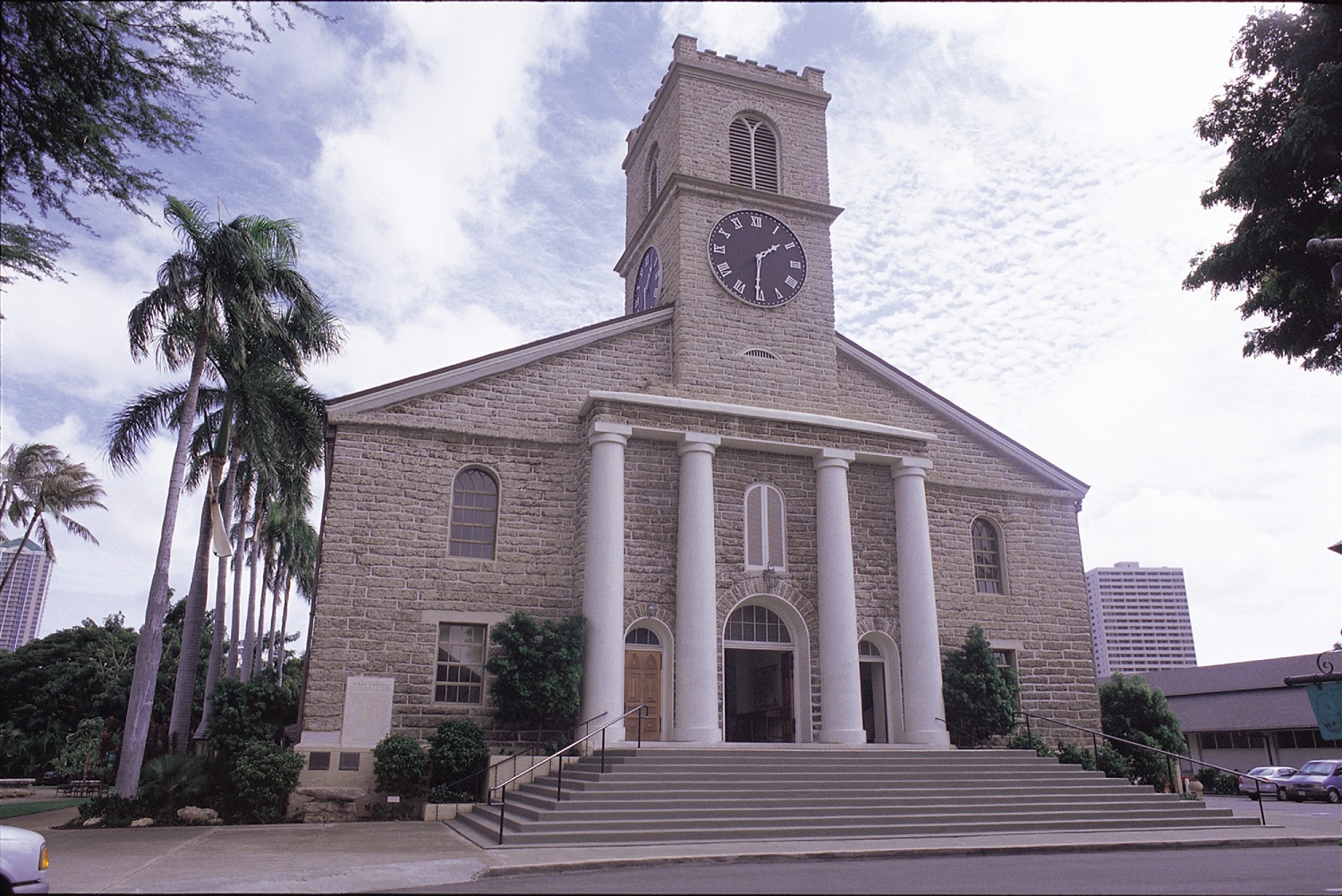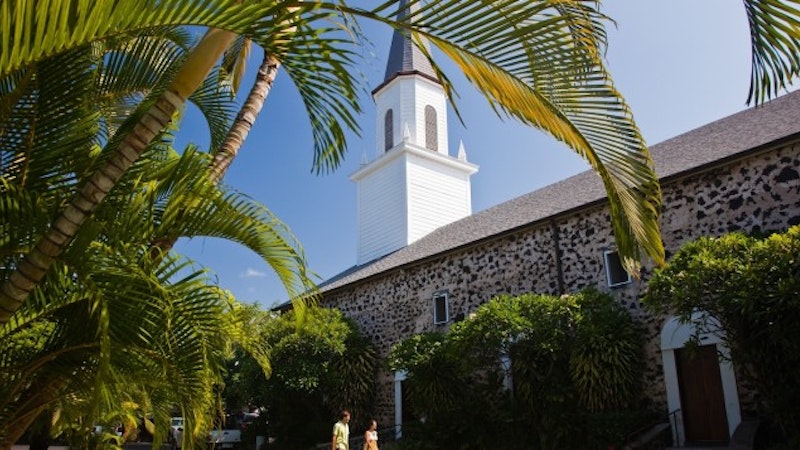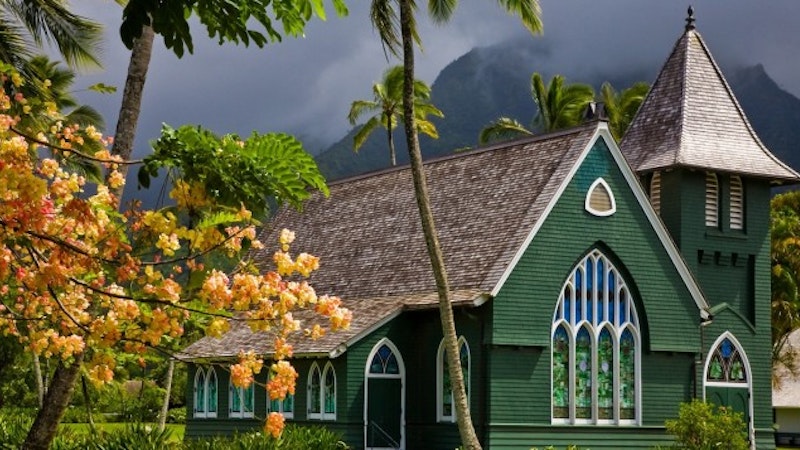Going to church may not the be activity number one on your Hawaii “To-Do” list, but, you may want to make it a priority! That’s because Hawaii is full of historical (and beautiful) 19th century religious houses that are full of history and rich tradition. You won’t regret taking a side-trip to visit these churches in Hawaii.
Most of the historical churches were built by missionaries, who came to Hawaii during the 19th century. When they first arrived in 1820, their timing couldn’t have been better. The ancient Kapu system (taboos and rituals which dictated the rules of the Kingdom) was gone, and there was no belief system to take its place.
So, the missionaries made quick work of establishing Christian churches throughout the islands, and much of their work is still here for locals and visitors to enjoy.
Here’s a look at some of the historical churches worth visiting while you’re in Hawaii:
Oahu:
- Kawaiahao Church:
Kawaiahao Church is a historic Congregational church located in Downtown Honolulu. The church plus the Mission Houses next door comprise Kawaiahaʻo Church and Mission Houses, a U.S. National Historic Landmark (designated in 1962). At one time, Kawaiahaʻo Church was the national church of the Hawaiian Kingdom and chapel of the royal family.
The Church was constructed between 1836 and 1842 of some 14,000 thousand-pound slabs of coral rock quarried from an offshore reef on the southern coast of Oahu. Hawaiian divers with hand tools dived 3 to 6 metres below sea-level to chisel out each coral block, which had then to be transported from the reef and onto shore.
Before her reign, then Princess Likiuokalani had been choir director at Kawaiahao Church.
The upper gallery of the church is adorned with 21 portraits of Hawaiian royalty Alii. King Lunalilo, who preferred to be buried in a church cemetery rather than the Royal Mausoleum, is buried in the courtyard.
- St. Andrews Church:
Kamehameha IV and Queen Emma, his queen consort, were devout members of the Church of England, led by their good friend Queen Victoria. At their request, Thomas Nettleship Staley was appointed bishop in 1862. Inspired to build a place of worship in the Anglican tradition, Kamehameha IV commissioned the construction of what would later become the Cathedral of Saint Andrew. However, the king died on the feast day of Saint Andrew in 1863 before ground-breaking. Kamehameha V, the king’s brother, took over the project and laid the cornerstone in honor of his predecessor on March 5, 1867.
Big Island (Hawaii Island):
- Mokuaikaua Church:
In 1820, Congregationalist missionaries from Boston crossed the Atlantic Ocean aboard the brig Thaddeus, rounded Cape Horn and 163 days later anchored off the village of Kailua on April 4. The Congregational Protestant missionaries were seven couples sent by the American Board of Commissioners for Foreign Missions and led by Hiram Bingham.
Completed in 1837, Mokuaikaua Church represents the new western architecture of early 19-century Hawaii. The original grass hale church was built in 1823, but was destroyed by fire in 1835. This stone and mortar building was likely built of stones taken from a nearby heiau and lime made of burned coral.
Mokuaikaua likely takes its name from a forest area above Kailua-Kona from which timbers were cut and dragged overland to construct the ceiling and interior.
- St. Benedict Roman Catholic Church (The Painted Church):
Overlooking Kealakekua Bay, St. Benedict’s Painted Church is a fascinating place to visit on your journey to the Big Island of Hawaii. Located in the famous Kona coffee growing region, it is the jewel of South Kona, at a place called Honaunau.
The Catholic church has been a part of life in SouthKona since 1842. The first church was located on the shore of Honaunau near the City of Refuge and was known as St. Francis Regis chapel. By the mid 1880’s, most of the folks had moved away from the beach to the cooler climate and more fertile soil to be found a bit higher on the slopes of Mauna Loa. Father John Berchmans Velghe, A Sacred Hearts father from Belgium, arrived in 1899 and decided to follow the local residents up the mountain slope. The folks dismantled the church and with the help of mules, moved it to its present location.
With repairs and additions the church looked like new. In August 1902 Bishop Ropert from Honolulu visited the relocated church, consecrated it, and named it in honor of St. Benedict, the father of Western monasticism. St. Benedict wrote the rule that is still followed today in most communities of monks.
Maui:
- Waiola Church:
The church was established in 1823 as a temporary structure built at Keawaiki, near the site of the present-day Lahaina Public Library. And, soon after, a new building, capable of accommodating 3,000 members was built at Wainee, at the current site of where the church stands today. That church was dedicated on March 4, 1832, becoming the first stone structure of its kind to be built on Maui.
Over the next 60 years, the stone church survived multiple rebuilding efforts after being damaged by fire in the infamous Kauaula winds of Lahaina. Then, through a gift of Henry P. Baldwin, a new Wainee Church was built in 1897 and endured for 50 years until the powerful Kauaula winds again destroyed the building on January 15, 1951.
Final reconstruction of Wainee Church was completed on April 26, 1953, and the building has remained in tact until today. The church also underwent a name change in 1954 from Wainee, meaning creeping waters, to Waiola, meaning living waters.
Queen Keopuolani is among the aliʻi buried in a royal tomb at Waiola Cemetery, along with her daughter, Princess Nahienaena. Also buried there, is King Kaumualii, last King of Kauai, among other royals.
- Kaahumanu Church:
Kaahumanu Church on High Street in downtown Wailuku is named for one of Hawaii’s first Christian converts, Queen Kaahumanu. The queen, who was the wife of Kamehameha I, was instrumental in breaking the ancient Hawaiian kapu(taboo) system, bringing an end to idol worship and abolishing traditional Hawaiian religion. This Congregational church was built in 1874, replacing another stone church built by Protestant missionaries in the 1830s.
- Holy Ghost Mission:
Portuguese immigrants built the Holy Ghost Mission in Maui’s Upcountry in 1894. The church’s unusual octagonal structure is the only one of its kind built during the 19th century in Hawaii. Its altar and 14 Stations of the Cross were brought from Austria in about 1897 and are priceless examples of museum quality 19th century ecclesiastical art. Hand-carved, gilded and painted more than a century ago by a master European craftsman, the words on the stations are in Old Portuguese. This is the only artwork of its kind in Hawaii. The church and artwork were restored for its 1994 centennial. Holy Ghost is listed on both the State and National Registers of Historical Places.
Kauai:
- Waioli Mission House and Church:
Step back in time at the 1837 home of the early Christian missionaries, Abner and Lucy Wilcox. This Hanalei town landmark, restored in 1921 and listed on the National Register of Historic Places, reflects the southern roots of its architect, the Reverend William Alexander of Kentucky.
Inside, synchronize your watch with the wall clock, which was installed in 1866 and still keeps perfect time. View the significant features like the lava rock chimney and the fine koa furniture. Lucy Wilcox gave birth to eight sons in the master bedroom, a significant feat on its own.
In front of the house is the old Waioli Huiia Church, which was founded in 1834. Its green shingles and stained glass windows are a picturesque symbol of Hanalei.
- St. Raphael Catholic Church:
The oldest Catholic Church in Kauai, St. Raphael’s was founded in 1841, two years after Catholics were granted religious freedom in Hawaii after the French threatened Honolulu. Father Arsenius Walsh established the parish.
The first stone chapel was built by Father Walsh in 1842. In preparation for the Centennial anniversary in 1941, the Chapel sanctuary was rebuilt by parishioners.
Molokai:
- St. Philomena Catholic Church:
St. Philomena Church was built at the Kalaupapa Leprosy Settlement on Molokai between 1872 and 1889. The initial church was constructed in 1872 by the Hansen’s disease patients living at Kalaupapa. Father Damien arrived in Kalawao in 1873 and helped expand the church twice. The work on the church’s second expansion finished the year after his death. St. Philomena is now a part of the Kalaupapa National Park under the management of the National Park Service.
It is the last structure on the peninsula which bears witness to Father Damien’s life and work in this “isolation colony” for those who suffered from Hansen’s disease. It was around this building that Father Damien centered his all-inclusive ministry on Molokai.
Although Hawaii is best-known for its beautiful beaches and abundant sunshine, these historic churches are most certainly worth visiting, even for vacationers who aren’t history-buffs. The agents at Hawaii-Aloha.com can even help you create a tour that visits some or all of these historic venues. Just click here to find a helpful agent.
One visit to these churches in Hawaii, and you’ll appreciate the hard work and dedication it took to establish new religions in a foreign land.






